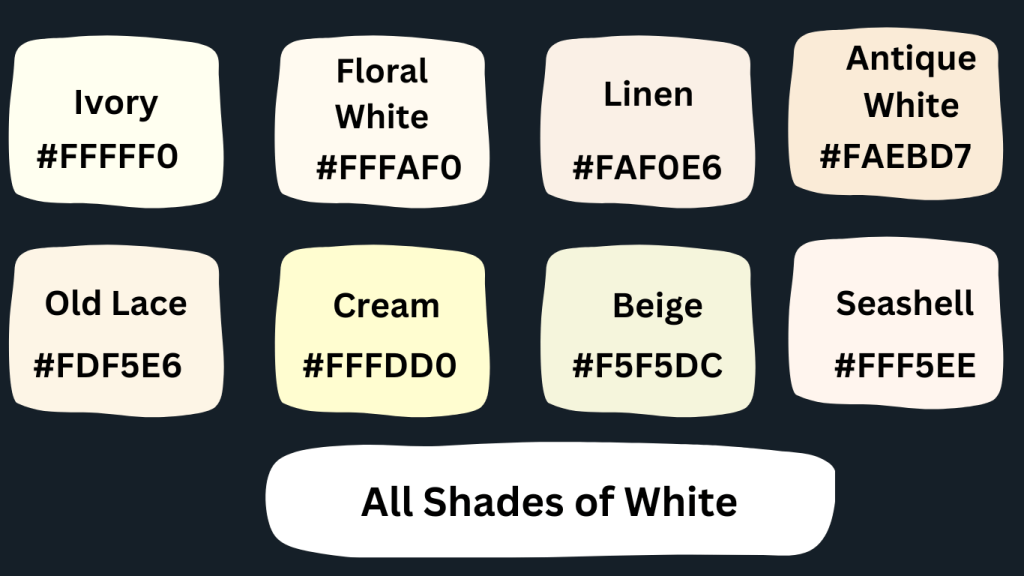
Are you looking for a comprehensive guide on all the different shades of white? Then you’ve come to the right place! This blog post will explain everything you need to know about the various shades of white, from the palest ivory to the most vibrant eggshell. We’ll also cover how to use each shade in your home décor and why it matters. In addition, we’ll provide tips for choosing the right shade of white for your space. So let’s dive into all the different shades of white and their unique characteristics!
The Basics of White
White is a timeless color that has been used in home décor for centuries. It’s a versatile hue that can be used to create a classic, modern, or even eclectic look depending on the shades you choose. In fact, white is one of the few colors that can truly bring any room together. When it comes to decorating with white, it’s important to choose the right shade for your space. Different shades of white can create vastly different looks, so it’s important to understand the subtle differences between them.
Different Shades of White
When it comes to white, there are many different shades to choose from. Each one has its own unique characteristics and can be used to create a variety of looks. Here are some of the most common shades of white and how they can be used in home décor:
Ivory (#FFFFF0)
Ivory is a soft, creamy white with yellow undertones.
It exudes elegance and sophistication, making it a popular choice for refined and classic designs
It pairs well with other gentle shades such as beige and cream. It’s an ideal choice for a bedroom since it’s calming and elegant.
Eggshell (#F0EAD6)
Eggshell is a slightly more vibrant shade of white with a hint of blue.
It has a more modern feel than ivory, making it perfect for contemporary spaces.
It offers a subtle warmth and is often used to create a gentle and inviting atmosphere.
Antique White (#FAEBD7)
Antique white is a rich, creamy shade with hints of gray and brown.
It has a timeless look that can bring a classic feel to a room.
It’s great for traditional spaces and pairs nicely with other warm colors such as red and orange.
Bright White (#FFFFFF)
Bright white is a stark, crisp shade of white with no undertones.
It lacks any significant undertones, making it a versatile option that complements a wide range of design styles.
It’s perfect for creating a bright, modern look in a room. It pairs well with bold, vibrant colors such as pink and purple.
Snow White (#FFFAFA)
Snow white is the lightest shade of white with no undertones.
It features a cool white tone and can evoke a sense of tranquility and serenity in a space. And is perfect for creating a clean, airy look in a room.
It pairs well with pastel colors such as mint green and light blue.
Alabaster (#F8F8FF)
Alabaster is a warm, pale shade of white with gray undertones.
It provides a subtle warmth and pairs well with both cool and warm color schemes.
It’s great for creating a subtle look in a room and pairs well with muted colors such as taupe and tan.
Choosing the Right Shade of White
Now that you know about the different shades of white, how do you choose the right one for your space? Here are a few tips to help you make the perfect selection:
Consider the Undertones
When choosing a shade of white, it’s important to consider the undertones. Different undertones can create vastly different looks, so it’s important to think about what kind of atmosphere you want to create in the space.
Think About the Color Palette
When selecting a shade of white, it’s also important to consider the other colors in the room. Different shades of white can look drastically different when paired with other colors, so it’s important to think about how they will work together.
Find Inspiration
If you’re having trouble deciding on a shade of white, it can be helpful to look at photos of rooms with similar styles. This can give you a better idea of how the different shades of white can be used in different spaces.
Conclusion
White is a timeless color that can be used to create a variety of looks. From the palest ivory to the brightest eggshell, there are many different shades of white to choose from. When selecting a shade of white for your space, it’s important to consider the undertones, the color palette, and any inspiration images you may have. With the right shade of white, you can create a stunning look in your home.
This blog post has provided a comprehensive guide to all the different shades of white and how to use them in your home décor. We hope it has been helpful in helping you choose the perfect shade of white for your space!
All Different Shades of White List
| Shade | Hex Code |
|---|---|
| Snow | #FFFFFF |
| Ivory | #FFFFF0 |
| Floral White | #FFFAF0 |
| Linen | #FAF0E6 |
| Antique White | #FAEBD7 |
| Old Lace | #FDF5E6 |
| Cream | #FFFDD0 |
| Beige | #F5F5DC |
| Seashell | #FFF5EE |
| Champagne | #F7E7CE |
| Ivory Cream | #FFF0F5 |
| Ghost White | #F8F8FF |
| Mint Cream | #F5FFFA |
| Azure Mist | #F0FFFF |
| Alice Blue | #F0F8FF |
| Lavender Blush | #FFF0F5 |
| White Smoke | #F5F5F5 |
| Floral Lace | #FFF9F9 |
| Cornsilk | #FFF8DC |
| Ghost | #F8F8FF |
